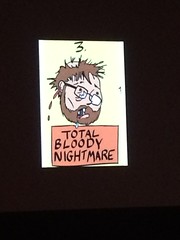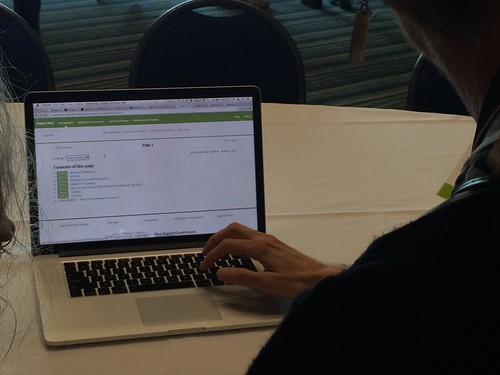Robyn Lees, library assistant at New Brighton, shares the highlights of her first ever visit to a National Digital Forum, held in Wellington in November last year.
Attending NDF

The Digital Forum has many facets and the areas of interest for me at the forum were learning and digital literacy, and how we can encompass it in to our programmes and general abilities of staff. As a part of going to the forum I was able to meet learned colleagues for whom a surprise collaboration with a very real result was achieved (more on that later).
Fun and…

Firstly I attended a pre-conference workshop that was about a very cheap system of computing called Raspberry Pi- to explain, Raspberry Pi is basically a miniature operating system that you can hold in your hand. It is like a motherboard of a computer about 5cms square. It has an operating system and can be plugged in to any existing system or operate independently as needed.

The trick is that you can learn basic programming and coding with it and it’s cheap. These would be great little tools for our learning spaces as the users can make lights work, make alarms or programme it to make actions. After we were shown some demos we got hands-on with Raspberry Pi and we were allowed to fiddle with them and put some basic programming in to them to make lights flash and set off alarms and other trickery. You can plug anything in to them like keyboards and USBs and screens so they are an appealing way of introducing some fun and coding to people with limited resources.
…Games

I was interested to learn about how organisations other than Libraries are engaging with new technology and using it to engage with their customers. Auckland Museum did a presentation about a Twitter campaign they ran where they used objects from their collection to convey clues accompanied by questions for users to answer. They ran a new quiz each week to keep users interested and tied it in with displays and events they were holding. It was hugely successful. This has inspired the team on to new ideas and new social media plans.
Baruk Fedderborn
Here is a clip from Auckland’s outreach librarian – Baruk Fedderborn. In general he is talking about Digital Literacy or as he terms it Post Literacy and engaging with Makerspaces in terms of Māori and Pasifika communities and how we can use our technologies to cross the digital divide and provide useful collaboration with these communities by way of language. It is best to let him explain.
Free Range

In line with my interest in ways of learning I saw a keynote address that began with Disrupt, Connect and Co-Construct. These are the go words of Clare Amos who is deputy principal at Hobsonville Point School where the style of learning is much different than how we were educated. The focus is on how to work with digital natives and support their different ways of learning. Recently I had a customer whose 2 year old son was fidgeting while I was signing him up. I gave him a toy plane to play with and he was not interested in it. So what does this mean for us?
The end bits
Some of my key notes are that there was a lot of conversation around how we get all our colleagues to invest and engage in the new technologies as we dive deeper and deeper down the rabbit hole. You don’t need to be 5 to understand it all –but it helps as our “digital natives” way of life changes how we offer our services. This leads on to us running programmes and designing our physical and digital spaces to fit what is happening now for customer needs and looking to build quickly in response to the fast paced changes in our society. Mostly it’s about being relevant and timely with our actions and training for Digital Literacy.
Which leads on to our most important function of customer service and making sure we are actually responding to what is needed and a small example of that is helping with CVs – it may not be glamorous but it’s important to the customers and we can use those sessions to promote all our fabulous services!
Glams 101
Baruk Fedderborn from the earlier conversation about Makerspaces and I found out that a lot of the forum attendees were keen to be able to communicate professionally with each other across the organisations there. These were Galleries, Libraries, Archives and Museums. We discussed planned and collaborated to create a platform for colleagues to do this and settled on Facebook as a suitable platform after discovering that it is frequently used by professional groups. We started a closed group called GLAMS 101 and have since grown the membership to over 120 colleagues and counting. They are located throughout NZ and range from management to customer facing colleagues. It has proved to be a very worthwhile and unexpected learning opportunity from the NDF 2015 Forum event.
The future
The two biggest stand outs for me for the future from the forum were:
- That people in these organisations want to share information and collaborate. Sharing of project information, expertise, resources etc are very possible for the future using social media platforms in addition to traditional methods.
- Everybody at the Forum was really excited about what will be coming in the future technology wise and how we can start to shift our mindsets to fully engage with such technologies like 3D printing and Robots which we have started to do, and think about the new ones coming like Virtual Reality and Nano Technology among many others.
Attending the Forum was a valuable experience and I recommend it to others for helping colleagues to learn and grow.



